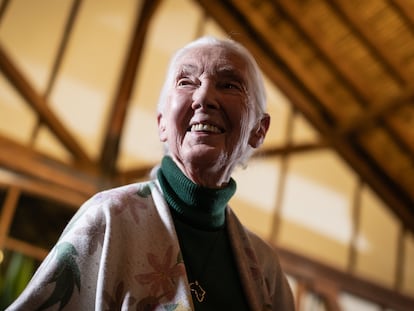Science has a new theory about the origin of kissing: A cleansing ritual among primates
A study suggests that the human act of kissing is a remnant of grooming, in which great apes use lip suction to clean the fur of their family and friends. But some experts remain skeptical

There are all kinds of kisses. They can be tender or passionate. They can be romantic or friendly. They can even be furtive and stolen. A kiss can change the course of history. But despite its infinite nuances, a new study published in Evolutionary Anthropology claims that they all have the same origin: a grooming practice in which chimpanzees and other great apes comb their companions’ fur with their fingers and use their lips to remove debris. Humans, the research suggests, inherited a vestige of that ritual.
How kissing went from being a fraternal and hygienic gesture among primates to becoming one of the greatest symbols of communion between people is what Adriano R. Lameira, an evolutionary psychologist at the University of Warwick (United Kingdom) and author of the article, has been studying for some time. The laboratory that he directs is in charge of tracing the evolutionary origins of humans’ most particular practices or characteristics, from dancing to imagination. Kissing is one of them. “If you think about it, it is a rather strange way of showing affection. We put our lips together and make sucking gestures that are random and intuitive,” he explains.
To understand the evolution that preceded the modern kiss, Lameira had to dive into the rabbit hole that scientific literature can sometimes be. He was looking for an answer. And he found not just one, but several. One of the existing theories proposes that lips evolved to be attractive and that is why we kiss. Another, that joining lips is a mechanism that some mammals found to smell each other closely and establish a certain compatibility. There is also a theory that establishes the origin of the kiss in premastication. That is, the parents of a primate chew food and then introduce it into the mouth of their offspring in a gesture similar to a kiss. A final assumption suggests that the kiss is a reflection of breastfeeding. “All of these may be valid, but most of them have a hard time explaining the way in which we kiss, the context of its use and its function,” explains the researcher.
The hypotheses were dismantled one by one. Premastication can explain the shape because the lips are pushed outwards, but there is no suction, quite the opposite. Breastfeeding does work a little better in terms of shape, but it would still have to be explained why, as adults, this behavior is transmuted into a practice on other parts of the body and is no longer related to food. The smell hypothesis falls apart because a hug is more effective for smelling each other than a kiss. “The only behavior in the repertoire of great apes that fulfils the same form, function and context as the modern kiss is the last step of grooming,” says Lameira. In this practice, primates check the fur of a partner in search of parasites, insects or debris. When they find it, the groomer approaches with protruding lips and makes a sucking movement to catch the residue found in the fur of their partner. “Suddenly, I found myself face to face with what probably represents the oldest form of kissing,” the researcher concludes.
Over the centuries, humans evolved to lose their fur. The study suggests that during that time, the hygienic function of grooming was lost and the ritual was condensed into the kiss as we know it today. “We no longer groom ourselves, but we kiss as a symbol, as if we had done so,” explains Lameira.
Sheril Kirshenbaum, a researcher and author of The Science of Kissing, says that “the hypothesis put forward by the new study is interesting” and could be added to the repertoire of existing conjectures, but it is not definitive because the practice of kissing has had several ups and downs throughout human history. It emerged and disappeared around the world at various times for a variety of social, emotional and even anatomical reasons. “With kissing, the good news is that we don’t need to choose a single explanation,” she says. In addition, it is not exclusively a human asset. Kirshenbaum stresses that “many other animals show behaviors similar to kissing that did not begin with us.”
The cultural burden
The question that remains to be answered is how much of this seemingly primitive relic of kissing has been influenced and modified by human cultural development. Kirshenbaum believes that the best answer, as is often the case, might be found somewhere in the middle. “Kissing is an example of a behavior where nature and culture complement each other. We seem to have an instinctive drive to connect in this way, but the form and interpretation of a kiss is determined by our upbringing and experiences,” she says. Lameira is more categorical: “Kissing is grooming with cultural development.”
The first kisses were recorded in Mesopotamia 4,500 years ago, according to a paper published in Science in 2023. The study compiles Sumerian and Akkadian writings that describe the practice of kissing with a dual function, as part of the sexual act and a display of affection between family and friends. Troels Pank Arbøll, a professor at the University of Copenhagen, expert on ancient Middle East civilizations and author of the research, has the following to say about the research published this month: “The author is trying to prove the credibility of the hypothesis he puts forward, which is fine in principle, although his inclusion and criticism of previous research or alternative theories seems superficial.”
For the Danish scientist, “it is curious that the article does not take into account recent and relevant research in anthropology, which offers alternative perspectives.” One of these was published in 2015 in American Anthropologist, which points out that there is no evidence that kissing is universal among humans, or even close to universal. Only 46% of the cultures sampled in this research had romantic kissing among their repertoire of rites and customs.
Many human rituals have been modified, but the kiss remains practically unchanged. It had other names and protocols, but it prevails. “Evolution does not discard things that work and does not fix what is not broken,” Lameira ventures.
For the kiss to change, something in our way of life would have to change as well. And even so, humans would look for a substitute. This happened during the Covid pandemic, when kissing became a vehicle for disease. “We will only manage not to kiss based on fear or responsibility,” psychiatrist and psychoanalyst Diego Figuera told EL PAÍS at the time. Caught up by the uncertainty of Covid-19, Figuera ventured that the kiss could take on a new meaning. “Those who dare to kiss in this time will experience it as an expression of great love for the other. I kiss you and I assume that you could infect me,” he said. And the kiss survived.
Sign up for our weekly newsletter to get more English-language news coverage from EL PAÍS USA Edition
Tu suscripción se está usando en otro dispositivo
¿Quieres añadir otro usuario a tu suscripción?
Si continúas leyendo en este dispositivo, no se podrá leer en el otro.
FlechaTu suscripción se está usando en otro dispositivo y solo puedes acceder a EL PAÍS desde un dispositivo a la vez.
Si quieres compartir tu cuenta, cambia tu suscripción a la modalidad Premium, así podrás añadir otro usuario. Cada uno accederá con su propia cuenta de email, lo que os permitirá personalizar vuestra experiencia en EL PAÍS.
¿Tienes una suscripción de empresa? Accede aquí para contratar más cuentas.
En el caso de no saber quién está usando tu cuenta, te recomendamos cambiar tu contraseña aquí.
Si decides continuar compartiendo tu cuenta, este mensaje se mostrará en tu dispositivo y en el de la otra persona que está usando tu cuenta de forma indefinida, afectando a tu experiencia de lectura. Puedes consultar aquí los términos y condiciones de la suscripción digital.
More information
Archived In
Últimas noticias
Chris Martin, Taylor Swift, Elijah Wood and other famous wedding ‘crashers’
‘How does it feel to be a failure?’: Elizabeth Berkley’s journey from ‘Showgirls’ ridicule to vindication
The story of the Málaga virus: The code that haunted Google’s cybersecurity center director for 30 years
The impact of Ecuador’s mega-prison: A polluted river, cleared forests and military checkpoints
Most viewed
- Christian Louboutin: ‘Young people don’t want to be like their parents. And if their parents wear sneakers, they’re going to look for something else’
- The low-cost creative revolution: How technology is making art accessible to everyone
- Liset Menéndez de la Prida, neuroscientist: ‘It’s not normal to constantly seek pleasure; it’s important to be bored, to be calm’
- All the effects of gentrification in one corner of Mexico’s Colonia Roma
- December Social Security and SSI payments: Dates, double checks and the 2026 COLA increase










































